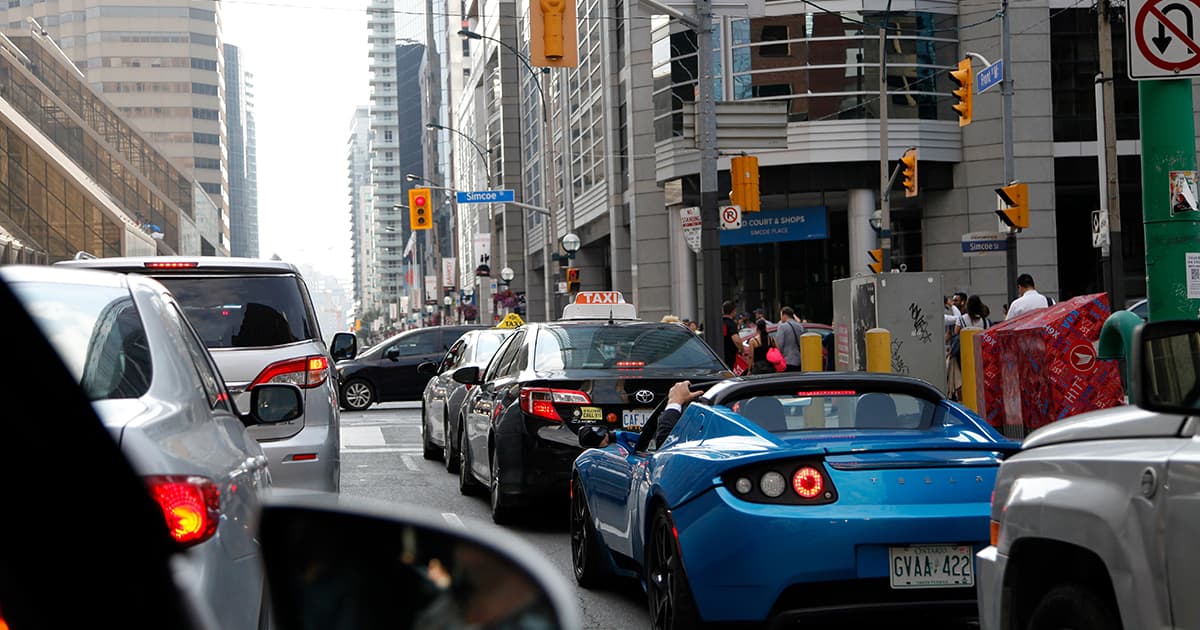Navigating the Hustle: How to Drive Safely in Busy Toronto Traffic

In the hustle and bustle of the Greater Toronto Area, driving can sometimes feel like a high-stakes game of who’s best at manoeuvring.
With super busy traffic in the Toronto area, Ontario drivers need to prioritize safety above all else. Whether you're a seasoned commuter or a new driver getting accustomed to the traffic rhythm, mastering the art of driving in busy traffic is essential.
Here are some safety tips to help you navigate the traffic jungle with confidence.
- Plan ahead: Before hitting the road, take a moment to plan your route. Use navigation apps like Google Maps or Waze to check for traffic congestion and find alternative routes if needed. Avoid peak rush hour times whenever possible to minimize your time spent in bumper-to-bumper traffic.
- Stay alert: In heavy Toronto- area traffic, it's easy to become distracted. Staying alert and focused on the road ahead is critical for your safety. Keep your eyes scanning for potential dangers, such as sudden lane changes, pedestrians crossing, or vehicles braking unexpectedly.
- Maintain a safe following distance: Tailgating can be common on Toronto's highways, but it's a dangerous habit that can lead to rear-end collisions. Maintain a safe following distance of at least three seconds between you and the vehicle in front of you. Increase this distance during bad weather conditions or when driving at high speeds.
Did you know? Highway 401 where it passes through Toronto is the busiest highway in North America. It’s also one of the top 10 busiest and widest highways in the world.
- Use your signals: Other drivers can’t read your mind. Communication is key in heavy traffic. Use your turn signals to indicate your intentions to other drivers, whether you're changing lanes, merging onto the highway, or making a turn. This helps reduce the likelihood of misunderstandings and promotes smoother traffic flow.
- Be patient: Patience is a virtue, especially when navigating congested roads. Resist the temptation to weave in and out of traffic or engage in aggressive driving behaviors. Remember that everyone on the road is trying to reach their destination safely, so practice tolerance and courtesy towards your fellow Ontario drivers.
- Avoid distractions: Texting, eating, or adjusting the radio while driving can divert your attention away from the road, increasing the risk of accidents. Keep distractions to a minimum by stowing away your phone, finishing meals before getting behind the wheel, and adjusting music or climate controls before setting off.
Did you know? Toronto ranks 3rd most congested city for traffic in North America.
- Stay Calm in traffic jams: Traffic jams are an inevitable part of Toronto driving, but how you react to them can make a big difference. Stay calm and composed, refraining from aggressive honking or gestures. Use the time stuck in traffic to listen to music, catch up on podcasts, or simply take a few deep breaths to relax.
- Watch out for cyclists and pedestrians: Toronto is a city teeming with cyclists and pedestrians, especially in downtown areas. Always be vigilant for cyclists in bike lanes and pedestrians crossing at intersections. Yield to pedestrians in crosswalks and give cyclists ample space when passing them on the road.
- Keep Your vehicle well-maintained: A well-maintained vehicle is less likely to have mechanical issues on the road. Regularly check your tires, brakes, lights, and fluid levels to ensure everything is in working order. Schedule routine maintenance checks with a trusted mechanic to address any potential issues promptly.
- Stay Informed about traffic regulations: Traffic laws and regulations can vary from city to city. Familiarize yourself with Ontario's traffic laws, including speed limits, right-of-way rules, and parking restrictions. Ignorance of the law is not an excuse, so stay informed to avoid unnecessary fines or penalties.
- Consider carpooling or public transit: If possible, explore alternative modes of transportation to reduce your reliance on driving in heavy traffic. Carpooling with colleagues or utilizing public transit options to get in and out of Toronto can help alleviate congestion on the roads while also reducing your carbon footprint.
- Practice defensive driving: Defensive driving involves anticipating potential hazards and taking proactive measures to avoid accidents. Stay aware of your surroundings, scan the road ahead for potential dangers, and be prepared to react quickly if a hazardous situation arises.
Remember, safety should always be your top priority as an Ontario driver. By following these tips and exercising caution on the road, you can navigate the GTA with confidence and peace of mind. Stay safe out there, and happy driving!
Did you know? Switching is Easy! Save up to 30% on car insurance when you switch to Western Financial Group.



